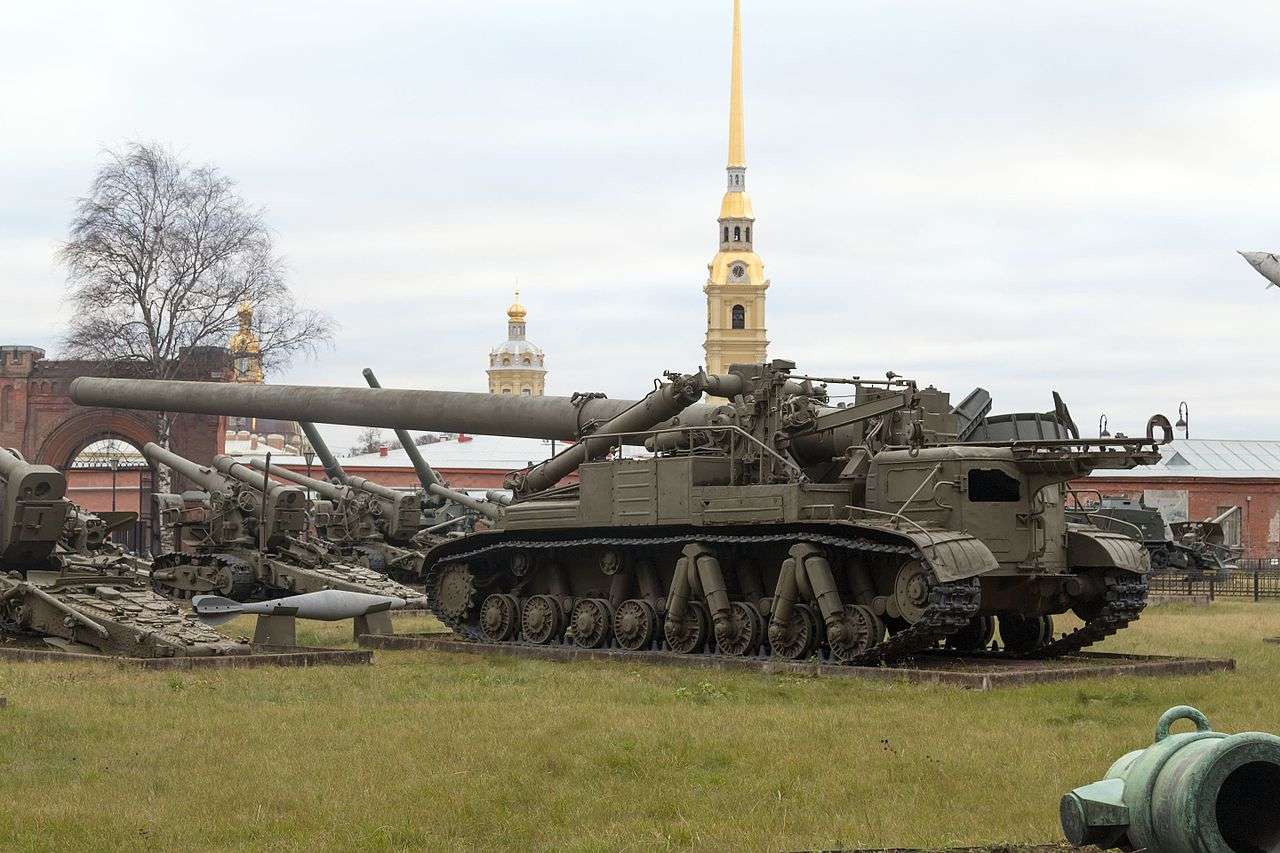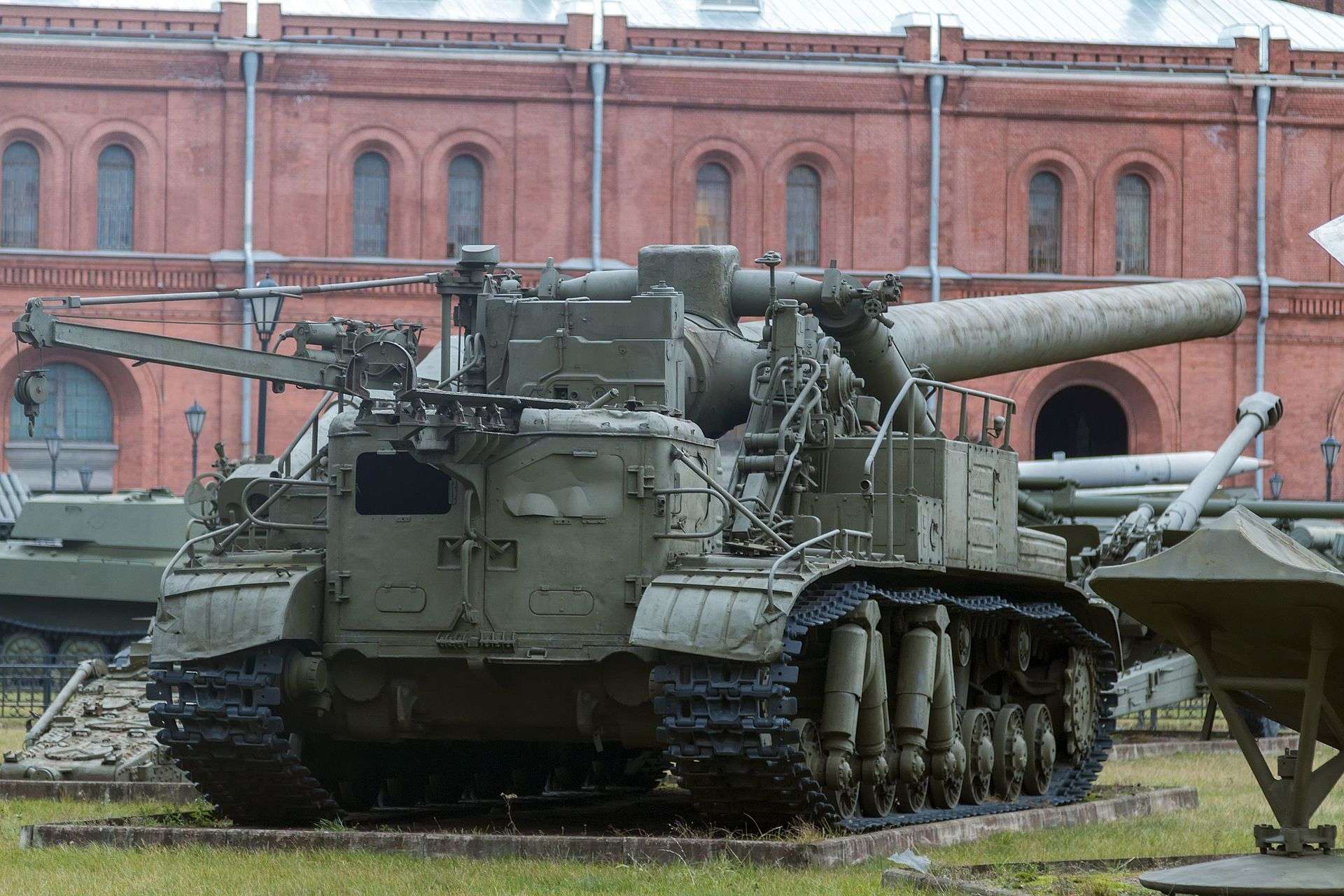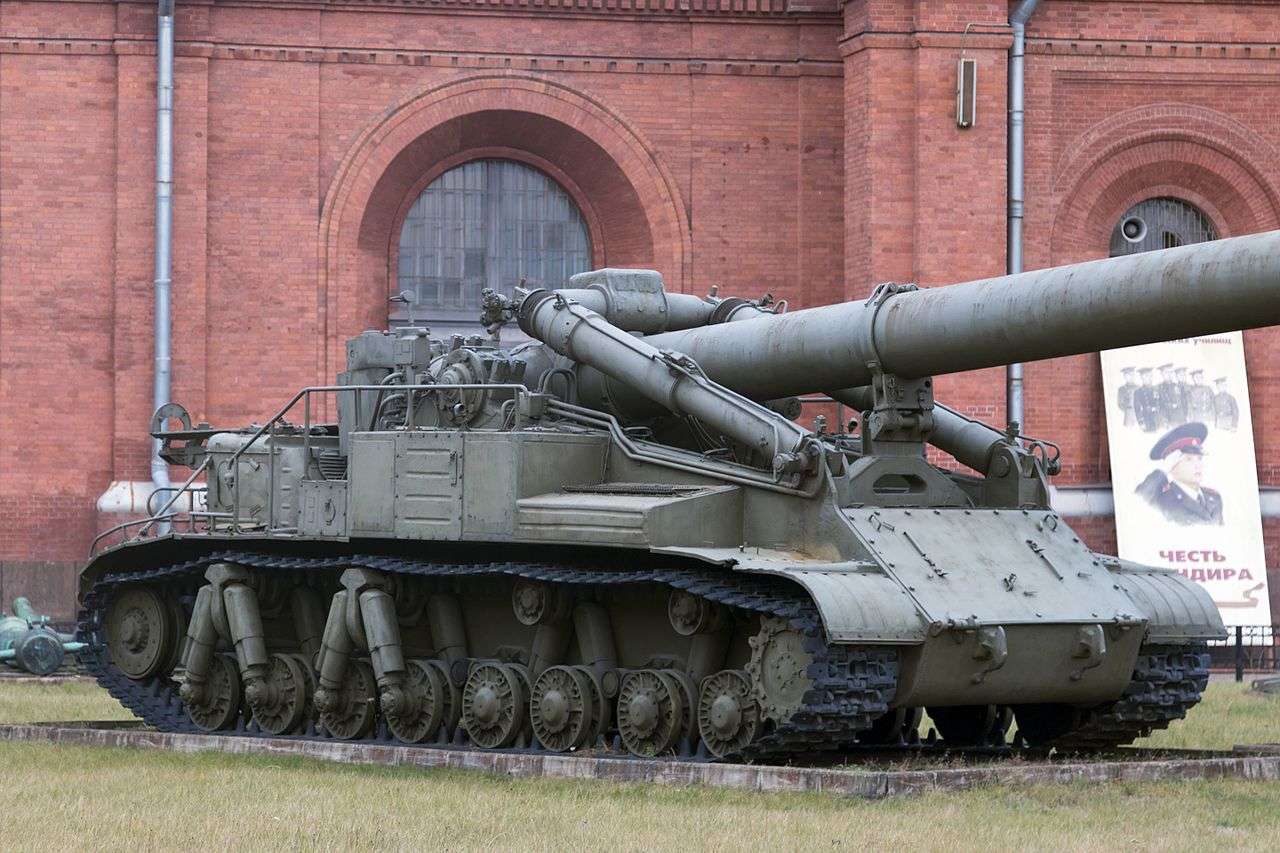
2B1 “Oka” – The SPG that Broke Itself When Firing
In 1957 the Soviets held their annual Victory Day parade on Red Square, celebrating the defeat of Nazi Germany in the great patriotic war. At this parade, foreign journalists, correspondents and photographers were shown a new type of Soviet vehicle, one with a 20 meter long barrel on the chassis of a T-10 heavy tank.
At the time many in the press listed this absurdly proportioned vehicle as a fake, a tool to instil fear and respect for Soviet military might. What they didn’t know was that this vehicle was anything but fake, it was the 2B1 “Oka”.
The 2B1 is a defining example of Soviet “flexing”. A 420 mm (16.5 inch) gun sat on top of an overburdened chassis – originally intended for the T-10 – that pretty much disassembled itself every time it fired.
Unsurprisingly, it wasn’t in service for very long.
Atomic Artillery
After WWII nuclear weapons were all the rage. Seen as the next big thing, many assumed any future large-scale wars would almost certainly involve their use. Militaries invested heavily in defending against them and using them.
Though they were touted as city-destroying weapons, it was quickly realised that smaller versions could have a significant impact on the battlefield. These are known as tactical nuclear weapons.
However at the time – before missile technology had matured – delivering a nuclear weapon was a cumbersome task. They are heavy, fragile, difficult to transport and needed to be detonated far away from friendly troops.
 The M65 atomic cannon, shown here shortly after firing a nuclear shell, were a stop gap before nuclear missile systems.
The M65 atomic cannon, shown here shortly after firing a nuclear shell, were a stop gap before nuclear missile systems.
The US created a relatively short-lived solution for this problem in the early 1950s with the M65 atomic cannon, or “Atomic Annie”. This was a 280 mm towed artillery piece capable of firing a 15 kt nuclear shell up to 20 miles away.
It entered service in 1955 and was soon deployed to Europe.
The Soviets, having no answer to this weapon, got to work creating their own version that same year.
2B1 Oka
Engineers were tasked with creating a mobile artillery system that could fire a nuclear shell out to a range of almost 30 miles (45 km). This was no easy task, reflected by the sheer ridiculousness of what they produced.
Their creation was the 2B1 Oka.
Oka is the name of the Oka River in Russia.
 The hilariously designed 2B1 Oka. Image by Mike1979 Russia CC BY-SA 4.0.
The hilariously designed 2B1 Oka. Image by Mike1979 Russia CC BY-SA 4.0.
It was comprised of two parts; the chassis, and an absolutely gigantic 420 mm (16.5 inch), 20 meter (66 ft) long gun.
The chassis was a highly modified T-10 hull, developed at the Kirov plant in Leningrad.
Visually, the hull appears to be “reversed” from the standard T-10, with the engine, transmission and drive sprockets at the front of the 2B1. This is similar to many other large self propelled guns built on pre-existing chassis, as the drivetrain would prevent placement of the gun.
 The rear of the 2B1, showing heavily reinforced rear wheels. Image by Mike1979 Russia CC BY-SA 4.0.
The rear of the 2B1, showing heavily reinforced rear wheels. Image by Mike1979 Russia CC BY-SA 4.0.
To help deal with the immense recoil, the rearmost roadwheels were heavily reinforced. It was powered by a turbocharged V12 diesel engine that developed 750 hp. However, its weight of 55 tons and impractical proportions meant that it had terrible mobility.
In action the 2B1 was operated by a large crew, but on the move it was crewed only by a driver. The rest followed behind in personnel carriers.
420 mm Gun
If you are reading about the 2B1 Oka, you are probably here to learn about one thing: its gun.
To put it simply, it was ludicrously large.
For example, the 420 mm gun of the 2B1 was bigger than the main armaments of the Iowa-class battleships, which carried 406 mm (16 inch) guns.
It could fire a 750 kg shell out to a range of 27 miles. This was especially handy for nuclear rounds, as it put crews at a “safe” distance from the detonation.
 The gun is around 20 meters long, with the entire vehicle measuring 26 meters in length.
The gun is around 20 meters long, with the entire vehicle measuring 26 meters in length.
Shells were loaded into the breech via a crane, giving it a lightning fast rate of fire of one round every five minutes.
While the gun technically achieved its objective of slinging massive rounds over massive distances, it completely crippled the system it was mounted on.
It could elevate up 75 degrees, but it lacked any traverse (side-to-side) movement whatsoever, requiring the entire vehicle to move when aiming. Engineers tried to address this with a specialist transmission that allowed more precise movements for fine laying of the gun.
It was braced with large shock absorbers, but even with these and the reinforced suspension, the 2B1 was still thrown around by the brutal recoil of the gun.
 The 2B1 fitted with shock absorbers around the gun to help deal with the savage recoil. These did very little to help, however.
The 2B1 fitted with shock absorbers around the gun to help deal with the savage recoil. These did very little to help, however.
Reportedly, the 2B1 rolled back five meters when fired.
In addition to this, the recoil tore the gearbox from its mountings and wrecked the suspension. Almost every component was pushed to its limits by the violent recoil. This caused the 2B1 to be embarrassingly unreliable.
It could be argued though that when firing a nuclear projectile, it only needed to work once.
Fate of the 2B1
In 1957 the 2B1 Oka was unveiled to the public at a parade in Moscow. It wowed international spectators, who were so stunned by the 26 meter long vehicle that they refused to believe it was real.
Behind the scenes though things weren’t going so smooth. The sheer power of the gun rattled the 2B1 to pieces and couldn’t be controlled despite numerous efforts to do so.
Not only was it a hazard to itself, it was a hazard to Soviet logistical systems, which struggled to operate and transport the machine.
 Engineers were simply unable to get the vehicle to a point where it could survive firing its own gun. Image by Mike1979 Russia CC BY-SA 4.0.
Engineers were simply unable to get the vehicle to a point where it could survive firing its own gun. Image by Mike1979 Russia CC BY-SA 4.0.
Even operating under its own power, the 2B1 was simply too long to be practical. These issues alone would have likely ended the project, but they were compounded by developments in missile technology.
Now, missiles could do the job of the 2B1 with much better accuracy and without the risk of knocking off every chimney in a three mile radius when turning around.
Just three years after it had been unveiled, the 2B1 was pulled from Soviet service, as was the 2A3 Kondensator, a similar vehicle with a slightly smaller gun.
News
The Hanging Temple: China’s 1,500-Year-Old Cliffside Marvel of Faith and Engineering
The Hanging Temple: China’s 1,500-Year-Old Cliffside Marvel of Faith and Engineering Perched precariously on the cliffs of Mount Heng in Shanxi Province, China, the Hanging Temple, also known as Xuankong Temple, Hengshan Hanging Temple, or Hanging Monastery, is an architectural…
The Willendorf Venus: A 30,000-Year-Old Masterpiece Reveals Astonishing Secrets
The Willendorf Venus: A 30,000-Year-Old Masterpiece Reveals Astonishing Secrets The “Willendorf Venus” stands as one of the most revered archaeological treasures from the Upper Paleolithic era. Discovered in 1908 by scientist Johann Veran near Willendorf, Austria, this small yet profound…
Unveiling the Maya: Hallucinogens and Rituals Beneath the Yucatán Ball Courts
Unveiling the Maya: Hallucinogens and Rituals Beneath the Yucatán Ball Courts New archaeological research has uncovered intriguing insights into the ritual practices of the ancient Maya civilization. The focus of this study is a ceremonial offering found beneath the sediment…
Uncovering the Oldest Agricultural Machine: The Threshing Sledge’s Neolithic Origins
Uncovering the Oldest Agricultural Machine: The Threshing Sledge’s Neolithic Origins The history of agricultural innovation is a fascinating journey that spans thousands of years, and one of the earliest known agricultural machines is the threshing sledge. Recently, a groundbreaking study…
Nara’s Ancient Sword: A 1,600-Year-Old Protector Against Evil Spirits
Nara’s Ancient Sword: A 1,600-Year-Old Protector Against Evil Spirits In a remarkable discovery that has captured the attention of archaeologists and historians alike, a 7.5-foot-long iron sword was unearthed from a 1,600-year-old burial mound in Nara, Japan. This oversized weapon,…
The Inflatable Plane, Dropped Behind the Lines for Downed Pilots
Experimental The Inflatable Plane, Dropped Behind the Lines for Downed Pilots The Inflatoplane from Goodyear was an unconventional aircraft developed by the Goodyear Aircraft Company, a branch of the renowned Goodyear Tire and Rubber Company, also famed for the Goodyear…
End of content
No more pages to load











